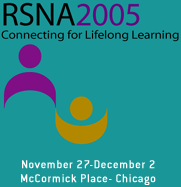
Abstract Archives of the RSNA, 2005
SSC05-01
First 3D Cardiac Images on a C-arm Angiography System Reconstructed with Retrospective Gating
Scientific Papers
Presented on November 28, 2005
Presented as part of SSC05: Cardiac (Multimodality)
Rebecca Fahrig PhD, Presenter: Nothing to Disclose
Jan Boese, Abstract Co-Author: Nothing to Disclose
Geunter Lauritsch, Abstract Co-Author: Nothing to Disclose
Norbert Strobel, Abstract Co-Author: Nothing to Disclose
Amin Al-Ahmad, Abstract Co-Author: Nothing to Disclose
Frandics Pak Chan MD, PhD, Abstract Co-Author: Nothing to Disclose
To investigate visualization of cardiac structures in volumes reconstructed from projections acquired on an interventional C-arm flat-panel detector (FD) angiography system.
A Siemens AXIOM Artis dTA FD C-arm system (Siemens Medical Solutions, Forchheim, Germany) was modified to allow acquisition of several bi-directional sweeps through 200 images during synchronized acquisition of the ECG signal. Protocols with 4 to 6 sweeps were investigated, with the number of images per sweep from 96 to 247, and total acquisition time from 16 to 40 sec. Our software for retrospective gating allows specification of a cardiac phase for reconstruction, selecting for each angle the image that is closest to this cardiac phase. Enhanced C-arm 3D reconstruction software (DynaCT) is used. 3D image quality was tested in two in vivo porcine models (heart rate ~ 90 bpm) for data acquired during injection of 2 cc/s and 3 cc/s (282 mg/ml I) into the IVC and was compared to gold standard, clinical gated cardiac MDCT images acquired on the same day with the same injection protocol (Siemens SOMATOM Sensation 16, single rotation in 0.42 s). The lengths of the right coronary (RCA), left anterior descending (LAD) and left circonflex (LCx) were measured in the clinical CT and 3D C-arm volumes.
Length measurements of the RCA, LAD and LCx showed that for experiment #1, 35%, 64% and 98% of the vessels respectively could be seen in the reconstructed 3D C-arm images relative to the CT images. For experiment #2, 85%, 65% and 45% of the vessels could be seen in the C-arm results. All four heart chambers are well seen through out the cardiac cycle. The coronary veins, pulmonary arteries and veins are best seen at 80% RR-interval.
For the first time, it was possible to visualize cardiac anatomy in 3D using an angiography system and intravenous contrast injection. Further optimization to reduce radiation dose and acquisition time is underway. Providing cardiac volume reconstructions during interventional procedures will be useful for on-line planning and guidance in a number of applications, including electrophysiology ablation procedures and interventional vascular procedures near the heart.
R.F.: Dr. Rebecca Fahrig is a member of the Siemens AX Physics Advisory Board.J.B.,G.L.,N.S.: Drs. Boese, Lauritsch and Strobel are employees of Siemens Medical Solutions.
Fahrig, R,
Boese, J,
Lauritsch, G,
Strobel, N,
Al-Ahmad, A,
Chan, F,
First 3D Cardiac Images on a C-arm Angiography System Reconstructed with Retrospective Gating. Radiological Society of North America 2005 Scientific Assembly and Annual Meeting, November 27 - December 2, 2005 ,Chicago IL.
http://archive.rsna.org/2005/4409396.html

